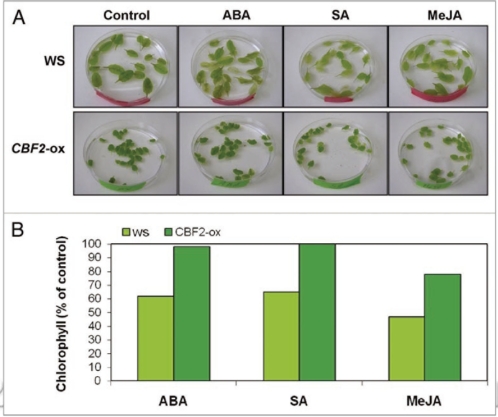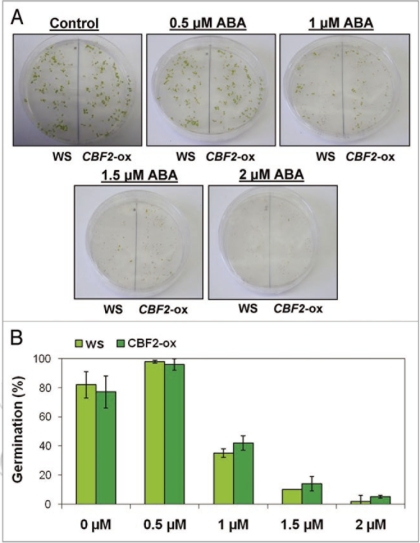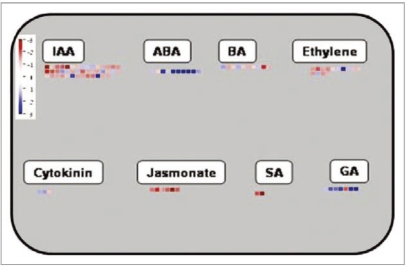Abstract
CBF1-3 (C-repeat binding factors) are transcriptional activators governing plant responses to low temperatures. Overexpression of CBF1-3 genes enhances plant frost tolerance, but also causes various pleiotropic effects regarding plant growth and development, mainly growth retardation, and delay of flowering and senescence. In a recent study, we reported that overexpression of CBF2 suppressed leaf senescence induced by the stress hormone ethylene. Here we show that overexpression of CBF2 also suppressed chlorophyll breakdown and leaf senescence induced by the phytohormones abscisic acid (ABA), salicylic acid (SA) and methyl jasmonate (MeJA), which indicates its broader role in suppressing hormone-induced leaf senescence. As previously reported for ethylene, the observed decrease in responsiveness to ABA in CBF2-overexpressing plants was specific to leaf senescence, since other responses to ABA were similar to those of wild-type plants. Transcript profiling analysis of hormone metabolism and responsive genes revealed that overexpression of CBF2 induced expression of ABA-biosynthesis and ABA-responsive genes and suppressed SA- and JA-related genes. Overall, in light of the adverse effects of CBF2 on ABA metabolism and responsiveness, on the one hand, and SA and JA metabolism and responsiveness, on the other hand, we conclude that overexpression of CBF2 suppresses hormone-induced leaf senescence by directly counteracting the hormone effects on leaf senescence and not by general suppression of their synthesis or signal transduction pathways.
Key words: abscisic acid, arabidopsis, CBF2, jasmonic acid, salicylic acid, senescence
Overexpression of CBF2 Suppresses Hormone-Induced Leaf Senescence
CBF1-3 proteins (C-repeat binding factors), also known as DREB1A-C (drought-responsive element binding1), are transcriptional regulators that bind specifically to the C-repeat cis-element present in the promoter regions of cold-responsive genes.1–3 Ectopic expression of CBF1 in Arabidopsis induced the expression of cold-regulation genes and significantly enhanced freezing tolerance.4 In addition to the effects on frost tolerance, overexpression of CBF1, CBF2 and CBF3 in Arabidopsis also causes various pleiotropic effects on plant growth and development, especially growth retardation, dwarfism, and delayed flowering and leaf senescence.3,5,6
Leaf senescence is stimulated by exposure to the plant hormones ethylene,7 abscisic acid (ABA),8 salicylic acid (SA)9 and jasmonic acid (JA).10 Recently, we reported that overexpression of CBF2 in Arabidopsis inhibited leaf senescence and chlorophyll breakdown induced by the plant hormone ethylene.11 In the present paper we show that overexpression of CBF2 also inhibited chlorophyll breakdown and leaf senescence induced by ABA, SA and MeJA. It can be seen that leaves of wild-type plants turned yellow shortly after incubation in solutions of these hormones, whereas those of the CBF2-overexpressing plants stayed green (Fig. 1A). Chlorophyll measurements revealed that exposure to ABA, SA and MeJA resulted in major decreases in chlorophyll content in wild-type leaves, to just 62, 65 and 48%, respectively, of their contents after incubation in water alone (Fig. 1B). In contrast, exposure to ABA, SA and MeJA decreased chlorophyll content to 98, 98 and 75%, respectively of its levels in CBF2-overexpressing plants incubated in water alone (Fig. 1B).
Figure 1.
Phytohormone-induced senescence of detached leaves of wild-type (WS2 ecotype), and CBF2-overexpressing plants. (A) Photographs of detached leaves after incubation in water (control), ABA (50 µM), SA (100 µM) and MeJA (50 µM). (B) Percentage of chlorophyll content remaining after exposure to the various hormones, as compared with that in leaves incubated in water. Chlorophyll measurements were performed in leaves 5 and 6, detached from rosettes harvested 36 days after sowing. Data in (B) are means of three different experiments, each including four replications.
Effect of CBF2 on Responsiveness to ABA
In a previous study, we showed that overexpression of CBF2 specifically counteracted the stimulating effects of ethylene on leaf senescence, but did not affect other plant responses to ethylene: etiolated seedlings of CBF2-overexpressing plants responded to ethylene in a similar manner to those of the wild-type.11 Similarly, we hereby show that overexpression of CBF2 specifically counteracted the effects of ABA on induction of leaf senescence, but did not affect other responses to the hormone, as increasing concentrations of ABA promoted seed dormancy12 and inhibited seed germination in a similar manner to that observed in wild type seeds (Fig. 2).
Figure 2.
Seed germination of wild-type (WS2 ecotype) and CBF2-overexpressing plants in the presence of increasing concentrations of ABA. (A) Photographs of seeds after 7 days growth in the presence of 0, 0.5, 1, 1.5 or 2 µM ABA. (B) Percentage of seed germination in the presence of various concentrations of ABA as compared with that of those grown without ABA. Data in (B) are means ± S.E. of two different experiments, each including 10–20 replications.
Effect of CBF2 on Transcription of Hormones Metabolism and Responsive Genes
In order to assess the molecular mechanisms involved in governing the responsiveness of CBF2-overexpressing plants to ABA, SA and JA, we performed transcript profiling of hormone metabolism and responsive genes, with the Affymetrix ATH1 genome array. By using MapMan13 software we found that overexpression of CBF2 induced the expression of ABA-biosynthesis and ABA-responsive genes in leaf tissue but rather suppressed the expression of SA- and JA-related genes (Fig. 3). For example, overexpression of CBF2 induced the expression of 9-cis-epoxycarotenoid dioxygenase, a key enzyme for ABA biosynthesis,14 and of several other ABA-responsive genes (Fig. 3). In contrast, overexpression of CBF2 suppressed the expression of two SA-biosynthesis genes, and five MeJA-biosynthesis genes, including three lipoxygenases, allene oxide synthase and jasmonic acid carboxyl methyltransferase.15 Furthermore, overexpression of CBF2 also suppressed the expression of ATMYC2, a transcription factor involved in mediating JA responses.16
Figure 3.
Transcript profiling analysis of hormone metabolism and hormone-responsive genes in mature leaves of CBF2-overexpressing plants. Transcripts that were expressed significantly differently in CBF2-overexpressing plants (p ≤ 0.05) on the Affymetrix AT H1 genome array data were categorized by using the MapMan software. Blue color represents upregulated genes and red color represents downregulated genes.
Overall, we showed that overexpression of CBF2 suppressed chlorophyll breakdown and leaf senescence induced by the phytohormones ethylene, ABA, SA and MeJA. In spite of its counteracting effect on leaf senescence, overexpression of CBF2 did not inhibit other plant responses governed by ethylene and ABA. Furthermore, transcript profiling analysis of hormone metabolism and hormoneresponsive genes revealed that overexpression of CBF2 induced ABA metabolism and ABA-responsive gene expression, but suppressed SA and JA metabolism and signal transduction genes. Therefore, we propose that overexpression of CBF2 suppresses hormone-induced leaf senescence by directly counteracting the hormone effects on leaf senescence and not by general suppression of their synthesis or signal transduction pathways.
Acknowledgements
This manuscript is contribution no. 566/09 from the Agricultural Research Organization, the Volcani Center, Bet Dagan 50250, Israel.
Addendum to: Sharabi-Schwager M, Samach A, Porat R. Overexpression of the CBF2 transcriptional activator in Arabidopsis suppresses the responsiveness of leaf tissue to the stress hormone ethylene. Plant Biol. 2009 doi: 10.1111/j.1438-8677.2009.00255.x. In press.
Footnotes
Previously published online: www.landesbioscience.com/journals/psb/article/10739
References
- 1.Stockinger EJ, Gilmour SJ, Thomashow MF. Arabidopsis thaliana CBF1 encodes an AP2 domain-containing transcriptional activator that binds to the C-repeat/DRE, a cis-acting DNA regulatory element that stimulates transcription in response to low temperature and water deficit. Proc Natl Acad Sci USA. 1997;94:1035–1040. doi: 10.1073/pnas.94.3.1035. [DOI] [PMC free article] [PubMed] [Google Scholar]
- 2.Gilmour SJ, Zarka DG, Stockinger EJ, Salazar MP, Houghton JM, Thomashow MF. Low temperature regulation of the Arabidopsis CBF family of AP2 transcriptional activators as an early step in cold-induced COR gene expression. Plant J. 1998;16:433–442. doi: 10.1046/j.1365-313x.1998.00310.x. [DOI] [PubMed] [Google Scholar]
- 3.Liu Q, Kasuga M, Sakuma Y, Abe H, Miura S, Yamaguchi-Shinozaki K, et al. Two transcription factors, DREB1 and DREB2, with an EREBP/AP2 DNA binding domain separate two cellular signal transduction pathways in drought- and low-temperature-responsive gene expression, respectively, in Arabidopsis. Plant Cell. 1998;10:1391–1406. doi: 10.1105/tpc.10.8.1391. [DOI] [PMC free article] [PubMed] [Google Scholar]
- 4.Jaglo-Ottosen KR, Gilmour SJ, Zarka DG, Schabenberger O, Thomashow MF. Arabidopsis CBF1 overexpression induces COR genes and enhances freezing tolerance. Science. 1998;280:104–106. doi: 10.1126/science.280.5360.104. [DOI] [PubMed] [Google Scholar]
- 5.Gilmour SJ, Fowler SG, Thomashow MF. Arabidopsis transcriptional activators CBF1, CBF2 and CBF3 have matching functional activities. Plant Mol Biol. 2004;54:767–781. doi: 10.1023/B:PLAN.0000040902.06881.d4. [DOI] [PubMed] [Google Scholar]
- 6.Sharabi-Schwager M, Lers A, Samach A, Guy CL, Porat R. Overexpression of the CBF2 transcriptional activator in Arabidopsis delays leaf senescence and extends plant longevity. J Exp Bot. 2009 doi: 10.1093/jxb/erp300. [DOI] [PMC free article] [PubMed] [Google Scholar]
- 7.Grbic V, Bleecker A. Ethylene regulates the timing of leaf senescence in Arabidopsis. Plant J. 1995;8:595–602. [Google Scholar]
- 8.Zeevaart JAD, Creekman RA. Metabolism and physiology of abscissic acid. Annu Rev Plant Physiol Plant Mol Biol. 1988;39:439–473. [Google Scholar]
- 9.Morris K, Mackerness AH, Page T, John CF, Murphy AM, Carr JP, et al. Salicylic acid has a role in regulating gene expression during leaf senescence. Plant J. 2000;23:677–685. doi: 10.1046/j.1365-313x.2000.00836.x. [DOI] [PubMed] [Google Scholar]
- 10.He Y, Fukushige H, Hildebrand DF, Gan S. Evidence supporting a role of jasmonic acid in Arabidopsis leaf senescence. Plant Physiol. 2002;128:876–884. doi: 10.1104/pp.010843. [DOI] [PMC free article] [PubMed] [Google Scholar]
- 11.Sharabi-Schwager M, Samach A, Porat R. Overexpression of the CBF2 transcriptional activator in Arabidopsis suppresses the responsiveness of leaf tissue to the stress hormone ethylene. Plant Biology. 2009 doi: 10.1111/j.1438-8677.2009.00255.x. [DOI] [PubMed] [Google Scholar]
- 12.Bewley JD. Seed Germination and Dormancy. Plant Cell. 1997;9:1055–1066. doi: 10.1105/tpc.9.7.1055. [DOI] [PMC free article] [PubMed] [Google Scholar]
- 13.Thimm O, Bläsing O, Gibon Y, Nagel A, Mayer S, Krüger P, et al. Mapman: a user-driven tool to display genomics data sets onto diagrams of metabolic pathways and other biological processes. Plant J. 2004;37:914–939. doi: 10.1111/j.1365-313x.2004.02016.x. [DOI] [PubMed] [Google Scholar]
- 14.Thompson AJ, Jackson AC, Symonds RC, Mulholland BJ, Dadswell AR, Blake PS, et al. Ectopic expression of a tomato 9-cis-epoxycarotenoid dioxygenase gene causes over-production of abscisic acid. Plant J. 2000;23:363–374. doi: 10.1046/j.1365-313x.2000.00789.x. [DOI] [PubMed] [Google Scholar]
- 15.Creelman RA, Mullet JE. Biosynthesis and action of jasmonates in plants. Annu Rev Plant Physiol Plant Mol Biol. 1997;48:355–381. doi: 10.1146/annurev.arplant.48.1.355. [DOI] [PubMed] [Google Scholar]
- 16.Dombrecht B, Xue GP, Sprague SJ, Kirkegaard JA, Ross JJ, Reid JB, et al. MYC2 Differentially Modulates Diverse Jasmonate-Dependent Functions in Arabidopsis. Plant Cell. 2007;19:2225–2245. doi: 10.1105/tpc.106.048017. [DOI] [PMC free article] [PubMed] [Google Scholar]





